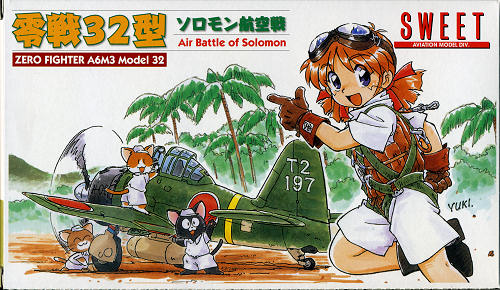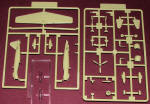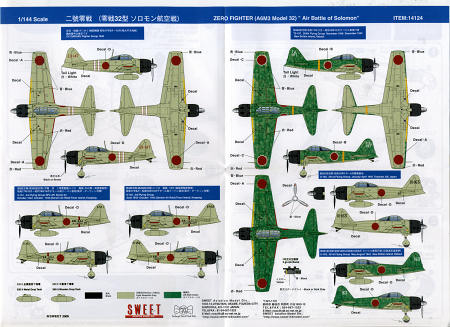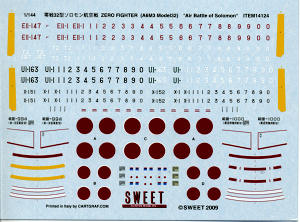
Sweet 1/144 A6M3 model 32-Battle of the Solomons
|
KIT # |
14124 |
|
PRICE: |
¥960 (about $12.25) at Hobby Link Japan |
|
DECALS: |
6 options |
|
REVIEWER: |
Scott Van Aken |
|
NOTES: |
Two kits |

|
HISTORY |
Undoubtedly the most successful Japanese aircraft of WWII was the A6M2 Zero. This early Zero was much feared by the Allies. Piloted by the most experienced pilots on either side (most of whom were enlisted), the Zero was able to rule the skies during the early days of the war. It wasn't until Allied pilots finally were able to discover the aircraft's weaknesses (mainly the lack of armor plating for pilot and fuel) that they were able to develop strategies for defeating it. Combine that with the loss of many of the more talented pilots during the battles for Guadalcanal, and the Zero stopped being so feared by the time that 1943 and the Corsair came into the picture.
|
THE KIT |
 There is a reason why this model company is called
Sweet. That is because it is one of the first things that you say when
you open the box. These folks make the finest 1/144 fighters ever
produced, and that is purely because they have thought things through
before producing the kits. Engineering is excellent as is the detail,
even in this scale. They are also quite easy to build with no real
fussing and fiddling about to get things to fit.
There is a reason why this model company is called
Sweet. That is because it is one of the first things that you say when
you open the box. These folks make the finest 1/144 fighters ever
produced, and that is purely because they have thought things through
before producing the kits. Engineering is excellent as is the detail,
even in this scale. They are also quite easy to build with no real
fussing and fiddling about to get things to fit.
This particular boxing is for the clipped wing A6M3 model 32 that was developed to offer improved performance at lower altitudes. So for that reason, it does not have folding wing tips. Many were operated from land bases so the tail hook was frequently removed to save weight.
This is, to my knowledge, the only clipped wing Zero currently kitted by Sweet and as usual, it contains two complete kits. About the only options on this one is the drop tank, and it is not absolutely necessary to have it. The kit is designed so that you do not have to install it if you don't wish. Providing a one-piece wing really helps with assembly as well. Land based Zeros often did not have the radio mast. This item was made of wood and frequently either not fitted at all or cut off even with the exterior of the canopy. The interior is devoid of additional bits like a seat, control stick or instrument panel, though few will really complain.
Instructions consist of a single folded sheet with a four step construction
sequence on one side and a full color decal placement guide on the other.
Painting info is given using Gunze paint references, a bit of an issue for
those in the US where the paint is no longer being imported. The decal sheet
itself is very nice an d provides enough markings to do the
two aircraft included. You have an option of either overall Ame-iro or with
a locally applied upper green. Apparently the leading edge yellow ID
markings were in use by this time as all of them are shown with it.
d provides enough markings to do the
two aircraft included. You have an option of either overall Ame-iro or with
a locally applied upper green. Apparently the leading edge yellow ID
markings were in use by this time as all of them are shown with it.
 Markings
are provided for EII-147 of the Zuikaku Fighter Group, X-151 and X-152 of
the 3rd Flying Group based on Timor, T2-197 of the 204th Flying Group based
on New Britain, and UI-163 of the 251st Flying Group as it appeared while
based at Toyohashi near Nagoya and again as deployed to New Britain. A
goodly number of extra numbers are also provided for those who wish to model
alternate aircraft from any of these units
Markings
are provided for EII-147 of the Zuikaku Fighter Group, X-151 and X-152 of
the 3rd Flying Group based on Timor, T2-197 of the 204th Flying Group based
on New Britain, and UI-163 of the 251st Flying Group as it appeared while
based at Toyohashi near Nagoya and again as deployed to New Britain. A
goodly number of extra numbers are also provided for those who wish to model
alternate aircraft from any of these units
|
CONCLUSIONS |
I built one of these kits from their initial release and liked it very much. They are not difficult, and while some of the small parts may cause the very young and very old some issues, the kits make into really nice replicas. Now that Sweet has done the Akagi group, one wonders if they will continue this trend into other carrier groups.
July 2012
Thanks to Hobby LInk Japan for the review kit. Get it here.
If you would like your product reviewed fairly and fairly quickly, please contact the editor or see other details in the Note to Contributors.